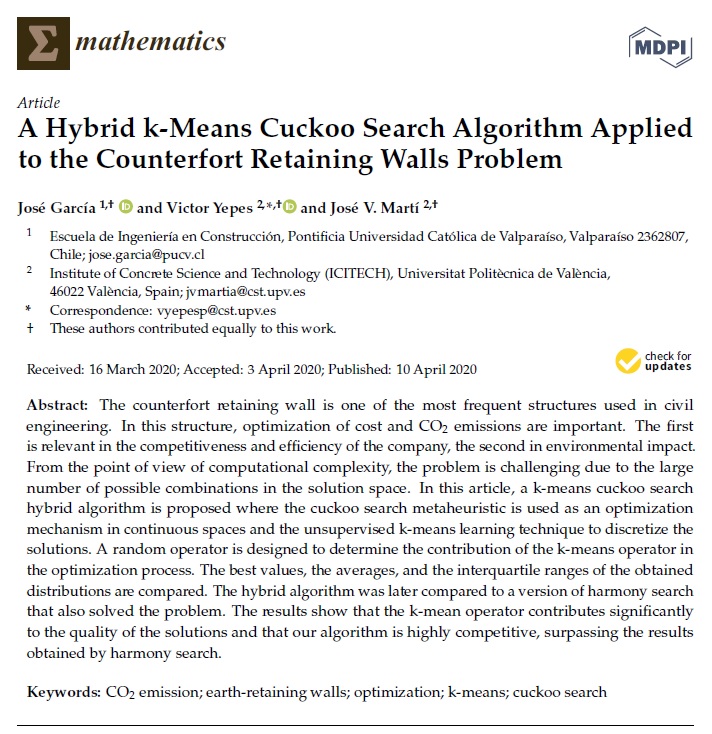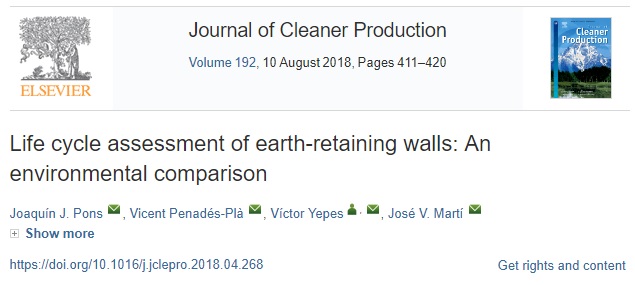 Acaban de publicarnos un artículo en la revista Mathematics, revista indexada en el primer cuartil del JCR. En este artículo se presenta un algoritmo híbrido de búsqueda del cuco y de clasificación no supervisada para optimizar el coste y las emisiones de CO2 de un muro de contrafuertes. El trabajo se enmarca dentro del proyecto de investigación DIMALIFE que dirijo como investigador principal en la Universitat Politècnica de València.
Acaban de publicarnos un artículo en la revista Mathematics, revista indexada en el primer cuartil del JCR. En este artículo se presenta un algoritmo híbrido de búsqueda del cuco y de clasificación no supervisada para optimizar el coste y las emisiones de CO2 de un muro de contrafuertes. El trabajo se enmarca dentro del proyecto de investigación DIMALIFE que dirijo como investigador principal en la Universitat Politècnica de València.
La Búsqueda Cuco se basa en la estrategia de reproducción de algunas especies de pájaros cucos. Éstos pájaros dejan sus huevos en los nidos de otros pájaros de otras especies para que éstas los críen, expulsando incluso los huevos del nido invadido. Si el pájaro anfitrión se percata que el huevo no es el propio, lo sacará del nido o directamente lo abandonará y construirá otro nido.
Por su parte, K-means es un algoritmo de clasificación no supervisada (clusterización) que agrupa objetos en k grupos basándose en sus características. El agrupamiento se realiza minimizando la suma de distancias entre cada objeto y el centroide de su grupo o cluster.
En este artículo se propone un algoritmo híbrido, en el que la metaheurística de búsqueda del cuco se utiliza como mecanismo de optimización en espacios continuos y la técnica de aprendizaje no supervisada k-means para discretizar las soluciones. Se diseña un operador aleatorio para determinar la contribución del operador k-means en el proceso de optimización. Se comparan los mejores valores, los promedios y los rangos intercuartiles de las distribuciones obtenidas. Los resultados muestran que el operador k-means contribuye significativamente a la calidad de las soluciones y que nuestro algoritmo es altamente competitivo.
Abstract
The counterfort retaining wall is one of the most frequent structures used in civil engineering. In this structure, optimization of cost and CO2 emissions are important. The first is relevant in the competitiveness and efficiency of the company, the second in environmental impact. From the point of view of computational complexity, the problem is challenging due to the large number of possible combinations in the solution space. In this article, a k-means cuckoo search hybrid algorithm is proposed where the cuckoo search metaheuristic is used as an optimization mechanism in continuous spaces and the unsupervised k-means learning technique to discretize the solutions. A random operator is designed to determine the contribution of the k-means operator in the optimization process. The best values, the averages, and the interquartile ranges of the obtained distributions are compared. The hybrid algorithm was later compared to a version of harmony search that also solved the problem. The results show that the k-mean operator contributes significantly to the quality of the solutions and that our algorithm is highly competitive, surpassing the results obtained by harmony search.
Keywords
CO2emission; earth-retaining walls; optimization; k-means; cuckoo search
Referencia:
GARCÍA, J.; YEPES, V.; MARTÍ, J.V. (2020). A hybrid k-means cuckoo search algorithm applied to the counterfort retaining walls problem. Mathematics, 8(4), 555. DOI:10.3390/math8040555


